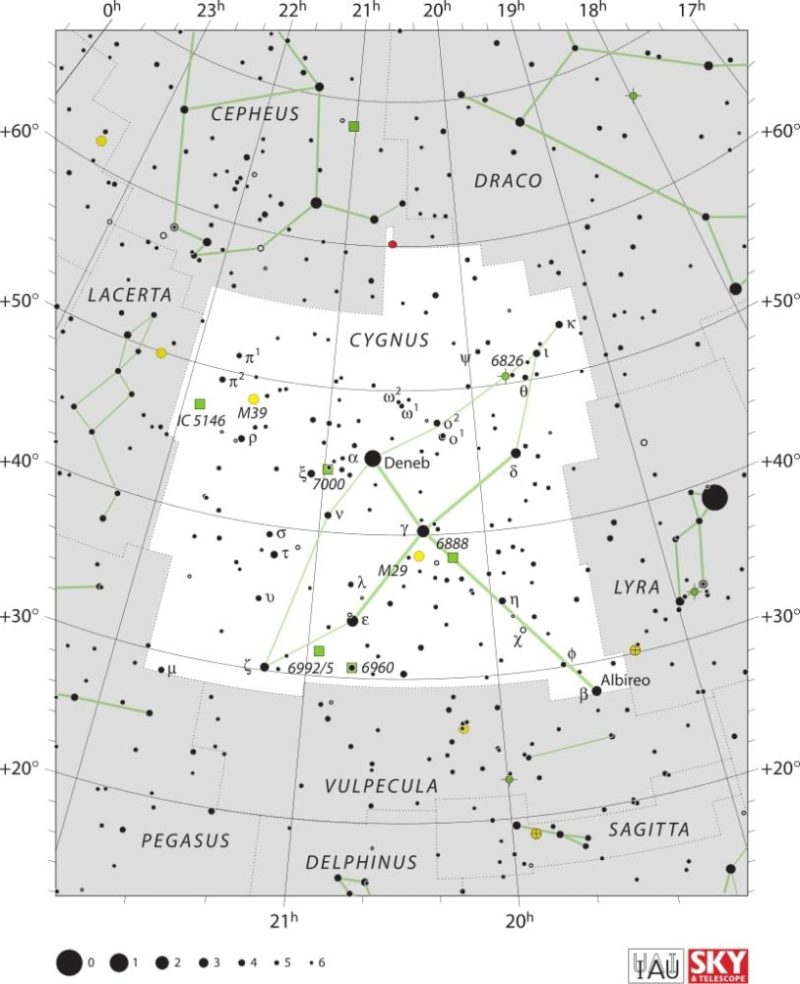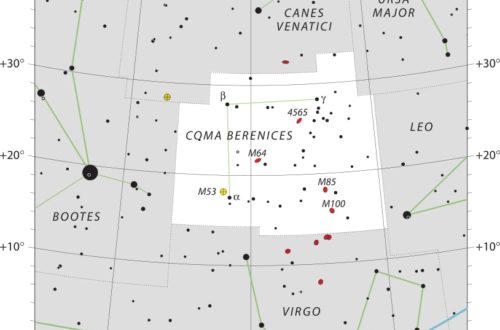Chi Cygnid Meteor Shower Guide

The Chi Cygnids are a weak variable rate meteor shower that occurs in September. The shower takes its name from Chi Cygni, a star in the constellation of Cygnus. This is the point in the sky from which the meteors seem to radiate.
Peak rates are variable, but generally low. One of the nicest things about these meteors is how slowly they glide across the sky at 15 km/s. The Chi Cygnid meteor shower are best seen late at night, away from city lights, and do not need any special gear for viewing.
While they may not be as well-known as their larger counterparts, they help keep the fall season jam-packed with wonderful celestial happenings. More information on visibility, viewing tips, and background comes up right after, so read on!
What Are the Chi Cygnids?
The Chi Cygnids are one of the newly identified meteor showers. Their name comes from Chi Cygni, the star that is located about halfway up the base of the Northern Cross in the constellation Cygnus. This star is notable for its dramatic brightness variations.
Precise observational data eventually corroborated the meteor shower. Researchers tracked its radiant point back to the Chi Cygni region of the sky. Though the Chi Cygnids are a relatively inconspicuous meteor shower, they materialize in a glamorous fashion with sporadic activity and unexpected timing. For both amateur and professional astronomers, they are an important event to monitor closely.
Catching the Chi Cygnid meteor shower in the dark sky is a quiet pleasure. Unlike those great showers that illuminate the sky with numerous bright streaks, these meteors are much more subtle and rarer. With each sighting, it’s like I’ve won a lottery.
Where Do They Come From?
The Chi Cygnids’ parent comet is unknown, adding to the shower’s mystique. Most meteor showers are remnants of well-known comets, with the debris field extending along the comet’s orbit and causing meteor displays that are relatively predictable.
Like any new meteor shower, the Chi Cygnids have no known parent body, prompting astronomers to search for clues and continue their investigation. This mystery showcases how much more we have to understand about our solar neighborhood.
Pinpointing the Radiant Point
The radiant point is the “home base” in the sky. From this point, Chi Cygnid meteors radiate outward, carving a beautiful arc of light across the sky. The Chi Cygnids radiate near Chi Cygni, an interesting variable star in the constellation of Cygnus. This star is famous for its unpredictable fluctuation in brightness and colors.
Whether you plan to observe the shower or not, being able to identify the radiant’s location is important. This means you can determine the direction each meteor is coming from. You can attach each trail to the Chi Cygnid occurrence rather than associating it with space junk.
The Swan Constellation Connection
Since the Chi Cygnids’ radiant sits in Cygnus, the Swan, this constellation is one of the largest and easiest-to-find in the sky. Cygnus prominently rises high overhead in the Northern Hemisphere during summer and fall. For most, finding the shower is just a lot easier by using the “Northern Cross” shape.
The connection between meteor showers and constellations goes beyond navigation. What’s more, it’s a tradition that stretches back millennia, aiding skywatchers from the ancients to the modern day in signaling where to peer.
How Fast Do They Travel?
The Chi Cygnid meteors travel at a speed of 15 km/s. That’s a really low speed, meaning their streaks are slower and longer-lived.
In comparison, some showers, such as the Leonids, can be incredibly fast, with velocities above 70 km/s. The Chi Cygnids are usually seen as slow, consistent streaks of light across the nighttime sky. This provides observers plenty of time to witness each amazing display.
Slower meteors would be easier to see and photograph since they would travel through the sky longer.
Best Ways to See the Chi Cygnids
If you want to catch the Chi Cygnid meteor shower at its best, you’ll need to know when and how to look. With careful planning, good sky conditions, and the right location, this meteor shower can be a real showstopper for stargazers all over the world.
Finding the Peak Viewing Time
The Chi Cygnid meteor shower hits its peak on September 14. Some meteors can also be spotted between September 3 and 25.
Ideal Sky Conditions Needed
In order to see the full extent of the variable stars, clear dry nights provide the greatest view. Light pollution might wash out the fainter meteors, so make efforts to observe from a dark-sky site, away from the glow of city lights!
Don’t choose nights when haze is expected or during bright moonlight.
Gear You Might Consider (Or Not!)
Meteor showers are best observed with the bare eye, so a simple star chart or app usually trumps a telescope. Frankly, for most of you, a lawn chair and a measure of patience will be all you need.
The Science Behind the Streaks
Meteor showers, such as the Chi Cygnids, are a reminder of how small pieces of debris from space can create a beautiful display in our atmosphere. When Earth moves through a cloud of dust and rock left by comets or asteroids, these bits hit our atmosphere. The science behind this may seem straightforward, but there’s much more at play.
Tiny Dust, Big Impact
Nearly all meteors originate from dust grains rather than asteroids. Just one tiny grain, no larger than a speck of sand, can produce a dazzling flash. This dramatic flash stands in stark contrast to the stormy night sky.
That’s because as soon as they impact the air they begin to decelerate extremely quickly, causing them to heat up and become extremely luminous. As usual in science, the larger the particle, the brighter, longer, or more impressive the streak. For instance, the tiniest particles usually get burned up so quickly that they produce only the briefest, feeblest traces. Larger ones could be more long-lived and brighter.
Earth’s Journey Through Debris
Earth encounters these streams at fixed intervals along its orbit. Each year, the Chi Cygnids greet us as we cross a belt of debris. These streams are the result of previous encounters with comets or asteroids.
The debris field’s density, dispersion, and composition influence the number of meteors that we observe and their brightness.
Appreciating Cosmic Dust Trails
These cosmic dust trails teach us more about the evolution of our solar system. Tracking these cosmic dust trails shouldn’t be purely a scientific endeavor. Appreciating the sky’s wonder should be part of the experience too.
Conclusion
Chi Cygnids add a new, friendly face to the summer sky. Their unbroken trails create tangible memories, whether you enjoy them from your own backyard or an isolated swath of dark sky country. Millions of stargazers can experience this wonderful sight—even without using high-tech equipment. Gather up a buddy, spread out a quilt, and let the sky amaze you. Each September, these meteors are a reminder that the simplest things can still be most exciting.
Tell us what’s worked for you, and pass on your wisdom to fellow stargazers. There’s space for all of us under the sky, so keep looking up and your coffee steaming!
Frequently Asked Questions
What are the Chi Cygnids?
They are a meteor shower visible in the night sky by the constellation Cygnus and named after the star Chi Cygni.
When do the Chi Cygnids peak each year?
The Chi Cygnid meteor shower peak activity will be on September 14.
How are the Chi Cygnids different from major meteor showers?
For example, unlike the Perseids or Geminids, the Chi Cygnids are less prolific. Their streaks are much rarer, but can be just as spectacular and are well worth the wait for dedicated skywatchers.
What causes the Chi Cygnids meteor shower?
Chi Cygnids are produced when Earth travels through debris left by a comet or asteroid. As these particles enter our atmosphere, they vaporize, causing bright visible streaks in the sky.
See also:
- Previous meteor shower: Epsilon Eridanid Meteor Shower
- Next meteor shower: Daytime Sextantid Meteor Shower
Would you like to receive similar articles by email?





